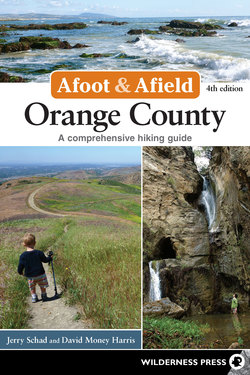Читать книгу Afoot and Afield: Orange County - Jerry Schad - Страница 20
На сайте Литреса книга снята с продажи.
Оглавлениеtrip 2.3 San Joaquin Wildlife Sanctuary
Distance 2–4 miles (loop)
Hiking Time 1–2 hours
Elevation Gain Negligible
Difficulty Easy
Trail Use Good for kids
Best Times All year, open dawn–dusk
Agency IRWD
DIRECTIONS Exit the 405 Freeway at Jamboree Road. Go south for 1 mile and turn left on Campus Drive. In 1 mile, make a U-turn at University Drive and an immediate right onto Riparian View, and follow it to the parking area for the wildlife sanctuary. Note that construction projects may change the preferred access at some point in the future.
As one of the richest wetland areas along the Southern California coast, the San Joaquin Wildlife Sanctuary offers an uncommon opportunity to come into contact with a natural ecosystem in the midst of Orange County’s high-rise urban core. Amid willows, bulrushes, and mulefat, you can spy on ducks, geese, and shorebirds, listen to songbird serenades, and perhaps even observe a bobcat and her kitten. You can thrill to the graceful antics of herons and egrets and the soaring flights of hawks and falcons.
Make no mistake, though, the entire 300-acre wetland, in its present incarnation, is an urban park, planted densely with native trees and shrubs and irrigated with recycled water from the state-of-the-art wastewater treatment plant. Starting in the early 1990s, the Irvine Ranch Water District, with the support of the Irvine Company and the Sea and Sage chapter of the Audubon Society, began an ambitious project to transform the former duck-hunting-club property into a naturalistic landscape typical of Orange County’s original lowland and upland habitats. That effort resulted in a dense system of more than 11 miles of wide, smooth, wheelchair-accessible trails, restrooms, resting benches galore, and, most importantly, first-class habitat for birds.
A nesting platform high on a pole in Pond 4 has attracted a pair of ospreys, which you may see diving for large fish in the ponds. Audubon volunteers have installed 100 nestboxes throughout the sanctuary to attract tree swallows, and they conduct a monthly bird census that has documented nearly 300 species of resident and migratory birds.
Start at the Audubon House nature center (open daily) by the parking lot, and pick up a free map. Naturalists offer regularly scheduled interpretive walks, and kids of all ages love the summer bat walks.
The most direct way to the heart of the sanctuary is to begin on Fledgling Loop, a broad dirt road starting by the parking area that leads between Ponds A–E. These ponds are used to hold treated water from the Michelson Wastewater Treatment Plant and act as emergency storage areas, but Ponds E and D are usually kept shallow to provide rare freshwater habitat for birds. These are favorite spots for bird photographers, especially in spring when shorebirds nest on the mudflat. (Note that visitors are required to stay on the established trails; don’t cut your own path down to the water.)
Watch for signs identifying the most common native plants along the trail, especially mulefat, California sagebrush, and coyote bush. Bladderpod and California wild rose are also plentiful. The three dominant trees in the sanctuary are willows (with long, skinny leaves), cottonwoods (with heart-shaped leaves), and sycamores (with white bark and hand-shaped leaves).
At a T-junction in 0.2 mile, turn right along Pond C, then veer left to follow a boardwalk through the wetlands. This is one of the more likely places to spot a resident bobcat. Lizards, butterflies, and dragonflies have the right-of-way here! Watch for splendid reflections of the willows in the placid waters.
Pond 1, San Joaquin Wildlife Sanctuary
A web of trails continues from the end of the boardwalk. Following specific directions would be difficult, and there’s no need to take a particular route because all of the sanctuary is interesting. Plan your loop to include some of the large ponds (1–4) on the southwest side of the sanctuary, which attract white pelicans, great blue herons, and other large fish-eating birds. These ponds contain water pumped in from San Diego Creek and help filter excess nitrates before the water is pumped back into the creek, which empties at Newport Back Bay. The thousands of American crows you may see roosting in trees at dusk represent an explosion in population, thanks to the plentiful food that they forage in neighboring communities.
A typical loop will cover 2–4 miles. Although most junctions are signed, it’s very easy to get lost in the dense web of trails through tall native vegetation. Monitor your progress on your map, and be sure to carry some water if the day is warm.
